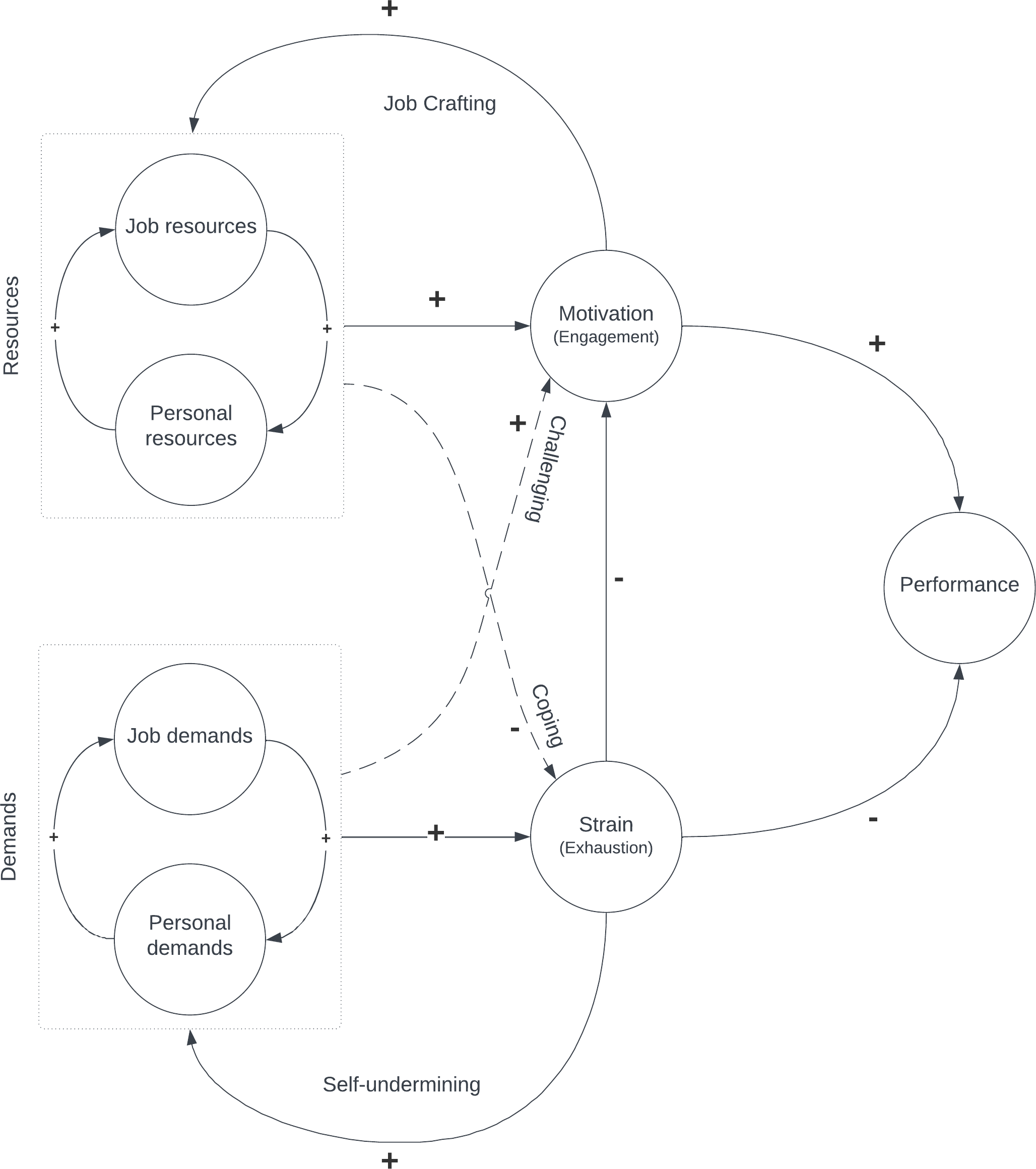Beware the Unintended Consequences of Process Improvement

The Job Demands-Resources (JD-R) model helps us understand the nuanced interplay between job demands, resources, and employee performance. While job resources enhance motivation and subsequently performance, job demands contribute to strain, negatively affecting performance. For successful process improvements, evaluating the impact of changes on the demands-resources ratio is crucial, as subtle shifts can lead to considerable performance variations.
The relationship between performance, job demands, and job resources is complex. Be careful: your quest for efficiency may undermine employee performance.
Small changes in the ratio of job demands to job resources can have an outsized effect on performance.
As you evaluate alternative “to be” process models, ask the following questions through the lens of the Job Demands-Resources (JD-R) model:
- How will changes to your business process impact job demands? Who will feel the impact?
- How will the proposed changes impact job resources? Again, who will be affected?
- Where are your employees on the performance curve?
- Within what time frame will the effects on job demands and resources become apparent?
Your answers will give you insights about how to help ensure your process changes will result in performance improvement.
The Job Demands-Resources Model
The JD-R model originated in psychology and has been validated by a broad range of research over the last 20 years. Here’s a representation of the model in the form of a causal loop diagram:

How to Read the Model
- Arrows represent causal relationships between two variables.
- A positive (+) relationship indicates an increase in one variable will cause an increase in the other variable.
- A negative (-) relationship indicates an increase in one variable will cause a decrease in the other variable.
- Arrows with dashed lines indicate secondary (weaker) causal relationships.
Performance
Motivation, which is primarily derived from job resources, has a positive impact on performance. On the other hand, strain, which is caused by job demands, tends to have a negative impact on performance. However, the interplay among these factors is complex and non-linear.

- Initially, as the ratio of job demands to job resources increases from low levels, performance tends to improve. A certain level of job demands—when supported by adequate job resources—can be stimulating.
- Performance increases at a decreasing rate as the ratio of job demands to job resources increases. At some point, a maximum level of performance is reached.
- As job demands relative to job resources continue to increase, performance decreases at an increasing rate.
In other words, small changes in the ratio of job demands to job resources can have an outsized effect on performance in many situations—particularly when the ratio is high.
Motivation and Resources
Job and personal resources boost motivation and engagement. Furthermore, research suggests that engaged employees stay engaged and create their own resources, which leads to even higher levels of motivation (“job crafting”). To an extent, job demands that require effort but promote personal growth and achievement can contribute to job resources and motivation (“challenging”).
Job Resources
Job resources are those physical, psychological, social, or organizational aspects of a job that help employees achieve their work goals or stimulate personal growth, learning, and development. Job resources initiate motivation and help buffer the effects of job demands on outcomes.
Contributors to job resources include:
- Social Support: Support from colleagues, supervisors, and the broader social environment.
- Autonomy: The level of control and discretion employees have over their work and decision-making.
- Skill Variety: The opportunity to utilize and develop a range of skills and abilities.
- Feedback: Regular and constructive feedback on performance and progress.
- Task Identity: The extent to which an individual can see the impact of their work from start to finish.
- Career Development: Opportunities for growth, advancement, and training.
- Job Security: Assurance of continued employment and protection against job loss.
Personal Resources
Personal resources in the form of a sense of self-efficacy and optimism may supplement and reinforce job resources.
Strain and Demands
Job and personal demands cause strain and can eventually undermine performance. In addition, employees under stress perceive and create more demands over time. They communicate poorly, make more mistakes, and create more conflicts (“self-undermining”). However, high levels of resources can help to buffer the impact of demands on strain (“coping”).
Job Demands
Job demands are physical, psychological, social, or organizational aspects of the job that require sustained effort. The essence of job demands is they consume energy because they must be fulfilled.
Contributors to job demands include the following:
- Workload: The amount and intensity of work, including time pressure and deadlines.
- Context Switching: Interruptions that require frequent switching between tasks or contexts.
- Exception Management: Dealing with unexpected situations, such as handling urgent requests, resolving issues, or addressing conflicts.
- Culture of Responsiveness: Exists when there is a high value placed on quick responses to emails, messages, or requests.
- Role Ambiguity: Uncertainty about job expectations and responsibilities.
- Role Conflict: Conflicting or incompatible demands from different roles or sources.
- Emotional Demands: The need to manage or suppress emotions, such as dealing with angry customers.
- Physical Demands: Physically strenuous activities, challenging working conditions, or exposure to hazards.
- Cognitive Demands: Complex problem-solving, decision-making, or information processing requirements.
- Interpersonal Demands: Difficulties in social interactions or relationships at work.
Personal Demands
Personal demands in the form of self-imposed expectations of behavior and job performance can heighten perceived job demands and strain.
Process Improvement and Employee Performance
Process improvement initiatives may have varied and conflicting impacts on job demands and resources and, hence, motivation, strain, and performance. For instance,
- Increases in task identity, opportunities for career development, and role clarity could lead to improved performance.
- An increased workload or perceived decreases in autonomy and job security could reduce performance.
The point is the harder you push a complex system, the harder it pushes back.
There is plenty of evidence to suggest people feel stressed:

As advocates of process innovation, it’s incumbent upon us to find ways to reduce the perceived ratio of job demands to job resources.
- First of all, we should work to understand the potential of process changes to increase job demands. I’ve found the Friction Report canvas to be helpful.
- Furthermore, we need to find ways to effectively communicate how our proposed process innovations are likely to reduce job demands and increase job resources over time.
The payoff can be significant. After all, a seemingly small reduction in the job demands to job resources ratio can have a disproportionately positive effect on performance.
